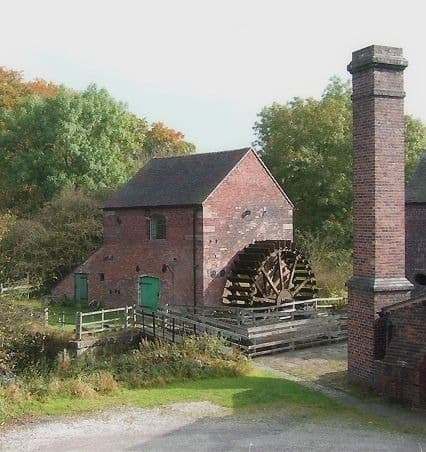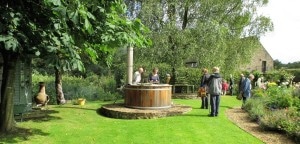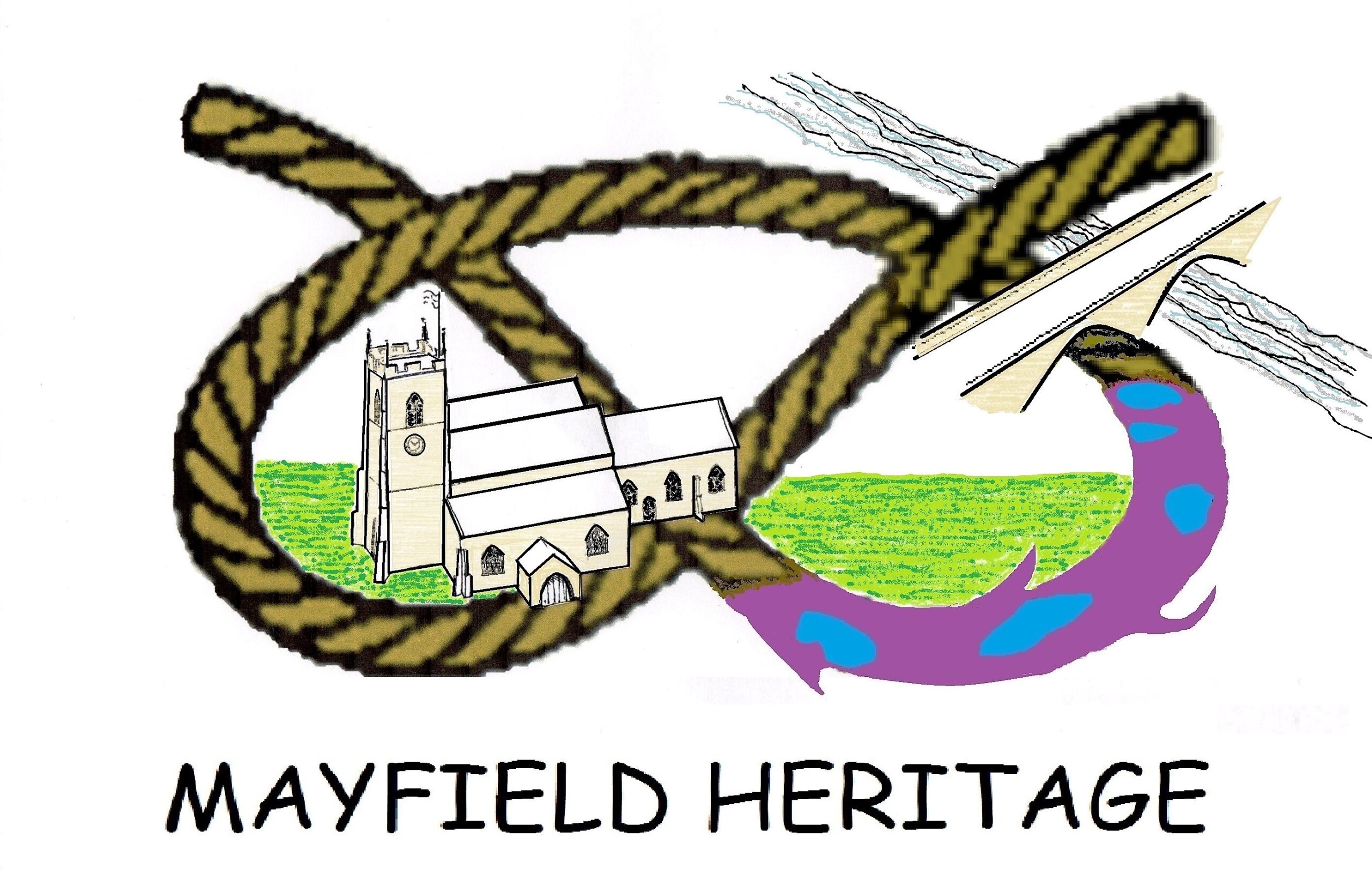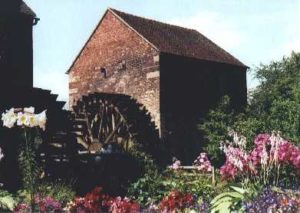Cheddleton Flint Mill and Heritage Trust
Friday 23rd March 2018 @ 7.00pm – Church Rooms

Cheddleton Flint Mill Industrial Heritage Trust celebrated its 50th birthday on 18th October 2017. Dr. John Outram, a trustee, will give an interesting and informative talk about what the mill did, its history and its preservation as a museum by the Trust.
Some interesting information on Cheddleton Flint Mill
- The earliest reference to milling at Cheddleton mill dates to 1253 and a
 document, dated 1694, refers to corn milling at the site.
document, dated 1694, refers to corn milling at the site. - Cheddleton Flint Mill has been an important building in the corn milling industry and in the late 18th century the complex was converted to grind calcined flint for use in the pottery industry
- Josiah Wedgwood successfully marketed a new product called “creamware” which used calcined flint from Cheddleton Flint Mill

We hope you will join us at the Church Rooms on the 23rd March for this interesting and informative talk. Entrance is £3.00 per person and includes light refreshments.
Click here to download a copy of our poster about this talk.
A write up of the Talk on The Early History of Burton Abbey
On the 15th November in the Church Rooms, Fran Carlisle presented the
results of her comprehensive research into the history of Burton Abbey.
A few significant events in its chequered history are recounted below.
Mentioned in the Domesday Book, the Abbey was founded in the 7th century
by Irish noblewoman St. Modwen, when on her way to Rome she stopped in
Burton with her companions and established a house of prayer on Andressey
Island. Her first Church was dedicated to St Andrew. The importance of St.
Modwen’s action was to bring Christianity to the Kingdom of Mercia.
The settlement was refounded as a Benedictine Abbey circa 1003 by Wulfric
Spott, Earl of Mercia (who was possibly descended from King Alfred).
In 1520 Abbott William Beyne established the first Grammar School.
The Abbey was dissolved in 1539, later to become a Collegiate Church. It was
subsequently suppressed in 1549. when its lands and privileges were
conferred on Sir William Paget, ancestor of the Marquis of Anglesey.
The water around Burton had long been known to be favourable for the
brewing of beer. In around 1712 George Haine opened the River Trent
Navigation and a wharf was constructed within the precinct leading to the
development of Burton as the major centre of brewing it is today.
Fran’s talk was full of detail and descriptive comments of monastic lifestyle at
this time in history and led to lively discussion amongst the audience on the
notable people who had been involved in the abbey’s history.
Many thanks to Fran for her research in raising our awareness to the life and
work of Burton Abbey; and to Graham Moodie who set up our newly acquired
projector enabling Fran to illustrate her talk.
Burton Abbey around 1661
Click here to view presentation slides
Burton Abbey
Burton Abbey was founded in the 7th century by an Irish Saint called Modwen or Modwena and it was one of the earliest Christian establishments in Staffordshire. Until that time the region had been strictly pagan. Sadly the first Abbey was destroyed by the Great Heathen Army between 876-7 which had overwintered just downriver at Repton.

In 1002 the abbey was reestablished by a Saxon nobleman called Wulfric Spot who was the son of Wulfrun. During its colourful history, the abbey frequently suffered poor management and many of the excesses that eventually led to widespread dissatisfaction with the monastic system by the general public. Nevertheless, it was at the heart of Staffordshire throughout a very long period of its development.
‘Before the bells were hung: Joseph Simpson of Mayfield’

On Wednesday 27th September 28 members of the public joined Mayfield Heritage Group members for a presentation by Ben Simpson MBE on the life of his great-grandfather Joseph Simpson, one of the two brothers of Simpson Bros. of Mayfield Mill.
Ben said at the beginning of the evening that he was steering clear of talking too much about the mill as he was sure that local people would know much more about the mill and the properties built by his family than he did. He introduced himself as the son of the former Commissioner Metropolitan Police Sir Joseph Simpson KBE, Ben also told us of his late brother Joseph Mark Simpson who served as an officer with the British South Africa Police and also as a senior officer with Hong Kong Police.
Ben’s talk on the Simpson family history began with yeoman farmers in Westmoreland defending a tower from Scottish invaders and continued down the generations through such trades as iron and copper mining, coal mining in South Wales, brewing, cotton milling, tea merchants and many more.
Joseph Simpson was born in 1835 into a family of Quakers. Over the years Joseph was actively involved in charity work. He was a charity worker for the poor of London, a Poor Law Guardian and an Antislavery & Freedmen activist. It was due to Joseph’s keen support for the anti-slavery movement that he sailed to America to help the cause. It was on one of these visits that he met his future wife Agnes Alderson. The couple was married at Burlington, New Jersey in 1870. The newlyweds returned to England to live in Mayfield.
In 1866, having previously been involved in the cotton spinning industry, Joseph along with his brother George, leased the mill at Mayfield and began trading as Simpson Bros. The Simpsons lived at Mayfield House and Mayfield Cottage until Sunnyside was built for Joseph and Agnes and Fieldhead for George and his family. Joseph became a prominent figure in the area. He was a JP in both Staffordshire and Derbyshire, he served as a school governor, he was still active in local charities and towards the end of his life, he served as an elected Parish Councillor on the newly formed Mayfield Parish Council.
During his life, Joseph was a prolific letter writer. Ben has donated eighteen of his letters to the Anti-slavery collection at Rhodes House Library, part of the Bodleian Library at Oxford. More letters are in trust at other Anti-slavery collections.
After a short illness Joseph died in 1901. In 1902, as a memorial to Joseph, the Simpson family donated three extra bells to St. John the Baptist Church, Mayfield and funded the rehanging of the now peal of six. A large bronze plaque in the chancel of the church commemorates the donation of the bells. Joseph is buried in a family grave with his wife and alongside his son Arthur. In another part of the churchyard, there are the graves of four other members of the Simpson family.
Earlier in the day, Ben was taken on a tour of Mayfield House and the present mill. The tour had been arranged by mill manager Alan Bosworth, Alan also acted as tour guide. Pat Smith Mayfield Heritage Group member also went on the tour. Ben was the first Simpson for over seventy years to enter his families former home. Ben was quite surprised how large some of the rooms were. The tour of the mill took in some of the older parts of the mill that would have been built by Simpson Bros. The mill has some of the most modern warp processing machinery in the world. Alan explained how the processes work. After a walk by the riverside, the dam, the weir and The Terrace thanks and goodbyes were expressed. Ben stayed behind for a short while and walked his dog through what had once been his family’s once magnificent gardens
‘Before the bells were hung’ is a reference to three additional bells that were donated and hung in the village church to commemorate the death of Joseph Simpson. There is a plaque in the chancel of the church remembering Joseph Simpson.

For more information contact: mayfieldheritage@gmail.com
Photos that will bring back memories.

We have been contacted by a lady in Switzerland called Verena Buser who stayed with her husband at the Sunnyside Hotel in 1965. She and her husband took many photos around Mayfield and Ashbourne between 1965 and 1989. She has kindly sent the Group a selection of photographs from those years and we would like to share them with you.
Sunnyside Hotel was run by the Hanbury family in 1965 and Verena has fond memories of her time spent there. Her husband was working at the Nestle factory in Ashbourne for a few months. Hopefully, the photos will stir up some great memories you have of Mayfield, Ashbourne and Derby.
Please click on the thumbnail below and it will enlarge the selected photo. Let us have feedback or stories that theses photos bring to memory and we will share your stories and comments online.
[ngg_images source=”galleries” container_ids=”8″ display_type=”photocrati-nextgen_basic_slideshow” gallery_width=”600″ gallery_height=”400″ cycle_effect=”fade” cycle_interval=”10″ show_thumbnail_link=”0″ thumbnail_link_text=”[Show thumbnails]” order_by=”sortorder” order_direction=”DESC” returns=”included” maximum_entity_count=”500″]
To see the full set of photos please click here
An Afternoon with Thomas Moore
Thomas Moore’s Cottage, Slack Lane, Upper Mayfield
The Thomas Moore event was a success with everyone enjoying the tale of Tom Moore’s time spent in Mayfield along with some excellent singing and poetry readings. The sun came out and only the threat of the wind to blow the gazebo away gave a slight concern. A big thank you to all that attended and the members of the Heritage Group that helped to stage the event. It was a good afternoon.
A fuller review of the event will be posted shortly.
What Robert Burns is to Scotland Tom Moore is to Ireland and the Heritage Group is delighted to invite you to an enchanting afternoon in the wonderful

surroundings of Moore’s Cottage, Mayfield; the house which Tom and his family occupied whilst in Mayfield from 1813 to 1817. The enchanting afternoon will consist of a summary of Moore’s life until he left Mayfield, interspersed with his poems and beautiful songs. Thomas Moore an Irish poet, singer, songwriter, and entertainer, is now best remembered for the lyrics of”The Minstrel Boy” and “The Last Rose of Summer“. He was responsible, with John Murray, for burning Lord Byron’s memoirs after his death.”
Find out more about this incredibly talented man and enjoy refreshments of Pimms and canapés to complete the experience. Entrance will be by ticket only as space is limited and tickets cost £10 per person. Due to cancellations 4 tickets are now available.
For tickets please contact: Fran Carlisle Tel: 01335 345831 or Sharon Amy 01335 664079
Visit to Emma Bridgewater Factory 10th October 2016
In 1985 Emma Bridgewater wanted to give her mother a special c up and saucer for her birthday, but could not find anything suitable. It was out of this desire that the stylish and practical pottery we know today as Emma Bridgewater was born. Her solution was to make one herself. This led to manufacturing in a small way, before acquiring the Victorian building on the banks of the Caldon Canal in Stoke on Trent in 1966; originally the Meakin Brothers works. From small beginnings the company now employs over two hundred and seventy people.
up and saucer for her birthday, but could not find anything suitable. It was out of this desire that the stylish and practical pottery we know today as Emma Bridgewater was born. Her solution was to make one herself. This led to manufacturing in a small way, before acquiring the Victorian building on the banks of the Caldon Canal in Stoke on Trent in 1966; originally the Meakin Brothers works. From small beginnings the company now employs over two hundred and seventy people.
Karen, our guide, walked and talked us round the factory floor where we had the opportunity to observe several processes all of which require the individual attention of a skilled workforce: namely jiggers, jolliers, fettlers, casters and decorators to transform a piece of clay into a finished item of pottery. Each piece is touched by thirty pairs of hands and goes through two firing processes, with scrap clay being recycled up to the “biscuit firing” stage.
“Cylindricalware” is made using specially made moulds, a highly skilled part of the process. Slip, the consistency of custard, is poured in and allowed to dry naturally before being turned out and sponged down by fettlers to remove any rough edges; all part of quality control.
Three of our group had the opportunity to try their hand at forming a piece of “flatware” by throwing a flat slice of clay onto a metal disc, as had the Duchess of Cambridge when she visited the factory in 2015.
The decorating workshop was particularly interesting, as we were able to watch how the “sponge designs” are sculpted by overlaying an acetate template, which is then burnt with a specially adapted soldering iron to etch the design into a foam block, a bit like a potato cut. All the decorators need to be competent in eighteen to twenty-four patterns and adapt to the demands of production. Apparently very few mistakes are made and therefore the factory shop is often short of seconds!
The final process is the application of glaze and which is tinted to ensure the entire surface is covered enabling any overrun to be detected and sponged away prior to firing (the tint burns off in the firing kiln). The kilns are opened slowly to ensure the finished ware is adequately cooled.
Security is taken very seriously, and to prevent the manufacture of “fake copies” all pieces bear the factory mark, have a year stamp, and are initialled by the artist prior to firing.
The tour provided a wonderful insight into the creation of this very British product, and the chance to have lunch in the café surrounded by examples of work displayed in cabinets and picture frames. Indeed a cup of tea, sandwiches and cakes were all served on Emma Bridgewater ware! A great day out and very much enjoyed.
Mayfield Mill and The Terrace – A talk by Mr Pat Smith on 14th March 2016

Pat gave a very interesting and informative talk, guiding us through the manufacturing and social history of the Mill and the Terrace, illustrated with a wide range of resources photocopied from his collection of archive material.
The origins of Mayfield Mill can be traced back to the 14th Century, and described in 1371 as a corn mill, under the auspices of Tutbury Abbey. Following the dissolution of the monasteries, ownership passed through a number of hands, being converted to enable the production of cotton textiles.
The Simpson Brothers acquired the premises in 1874 and invested a sizeable sum in re-equipping the Mill for continued cotton production and building housing for their workforce in The Terrace and Conygree Lane. Sunnyside, now demolished, and Field Head were constructed for the Simpsons to take up residence in the village. Sadly, the business was liquidated in 1930 and the Mill premises and housing were advertised for sale. William Tatton of Leek purchased the business.
Having worked at the Mill from 1951 for a period of 10 years Pat was able to recall personal memories of the workforce, the lifestyle experienced by the residents of The Terrace, the progress in manufacturing innovation, and advancements in the power supply. Initially, this was water from the River Dove, followed by the in-house production of coal gas and generation of electricity, and eventual connection to the National Grid in 1952. During the period he was employed, nylon production was introduced. The legacy of synthetic fibre production continues today, under the management of Mayfield Yarns, part of the Allied Textile Group, which specialises in the manufacture of synthetic polyester technical textiles, working twenty-four hours across five days and employing a hundred people.
We were fortunate to have some of the mill management in the audience, as well as former employees, and residents of The Terrace, who were able to add their own experiences to make the evening a very enjoyable event. Cakes and refreshments were served to complete the evening’s entertainment.
Many thanks to Pat for sharing his knowledge with the Mayfield Heritage Group and friends.
Smedley Factory Visit – 24th November 2015
Twenty members of the Mayfield Heritage Group, plus friends, went to the historic Smedley Factory in the Derwent Valley on 24 November 2015 to visit the reputed oldest continuous working factory in the world. The factory was founded in 1784 by Peter Nightingale (a relation of Florence Nightingale) and John Smedley.

On a cold day, we were given a very warm welcome by the John Smedley team which included a fascinating talk and visual presentation on the history of the Smedley Factory and what the company is now doing to research its history. We were reminded of the importance of the Derwent Valley in promoting the Industrial revolution and the Smedley family’s role not just in developing the factory at Lea but also other investments in the area such as the hydrotherapy hotel, called Smedley’s Hydro, at Matlock (now the home of Derbyshire County Council).
The tour of the factory itself was fascinating seeing the way in which modern and highly specialised knitting machines mechanisation was blended with the individual skills of workers who, for example, were hand working garments to finish off the final quality product. It was emphasised on several occasions during the visit that only perfect products will be sold and this quality philosophy of the Smedley factory was evident on the way we were treated by all staff. Special thanks go to Jeannette Chorley at Smedley’s for arranging our visit and making us so welcome.
The visit to Smedley was a reminder of the wonderful heritage we have in our local area which in the case of the Derwent Valley is recognised in its UNESCO World Heritage Site designation received in 2001.
Friday 9th October: Talk on antique agricultural and horticultural hand tools by Graham and Judy White (Church Rooms at 7.30 pm)

Graham and Judy with their antique agricultural tools
Monday 21st September: 7.30 pm. Illustrated talk about Ashbourne Railway and its connection with Mayfield
Review: On Monday, September 21st Mayfield Heritage group hosted a delightful talk on the old Ashbourne Railway by Mark Tyack. The talk was beautifully illustrated with photos that brought back to life the past glory days when Ashbourne had a railway. One particularly interesting item was the tunnel under Church Street and how the road was raised to accommodate this. Mark spent much of his childhood hanging around the station and talking to the very friendly staff. Often he was able to ride on the footplate which left him with many happy memories and an abiding love for this particular form of transport. The audience had their memories too, which they were pleased to exchange with Mark. After the talk, we all enjoyed tea and cakes which rounded off a very pleasant evening.
Monday 10th August: An afternoon visit to the NGS ‘Colour Mill’ garden at Winkhill with afternoon tea.


 document, dated 1694, refers to corn milling at the site.
document, dated 1694, refers to corn milling at the site.
